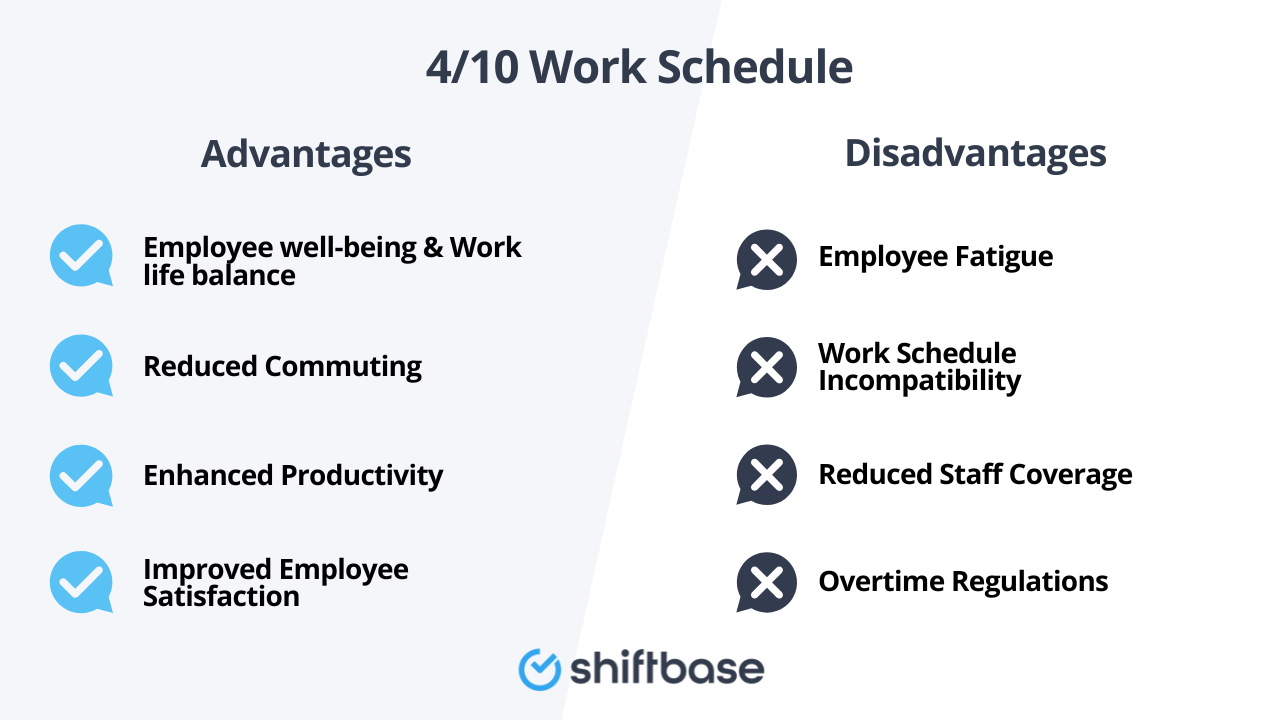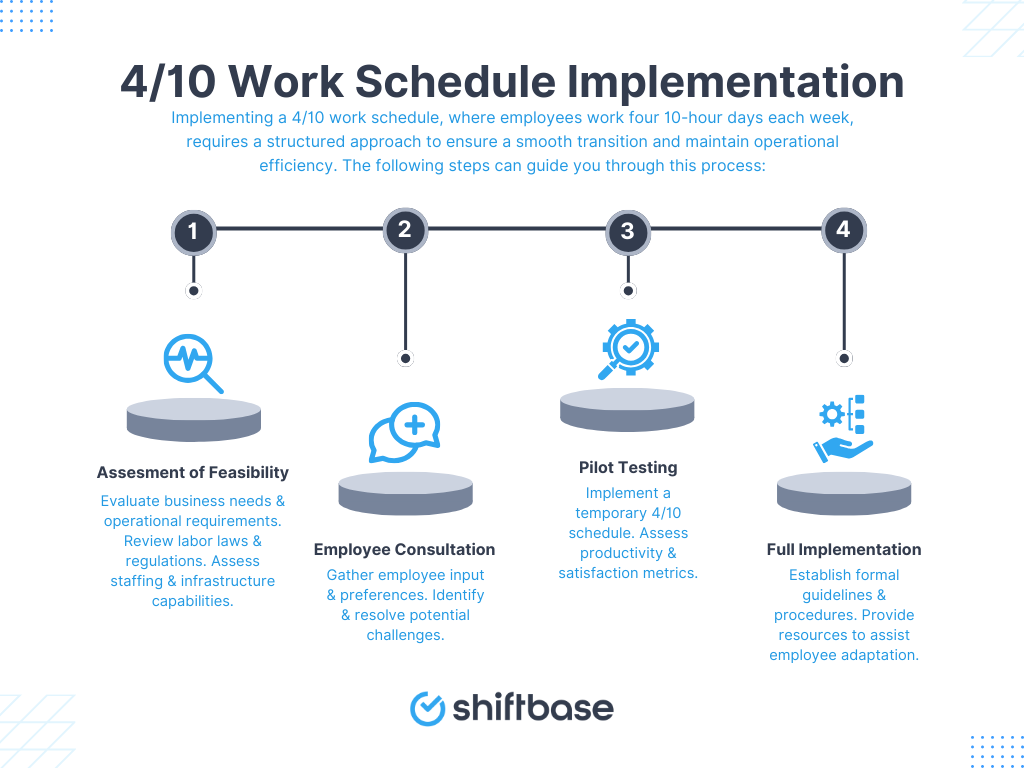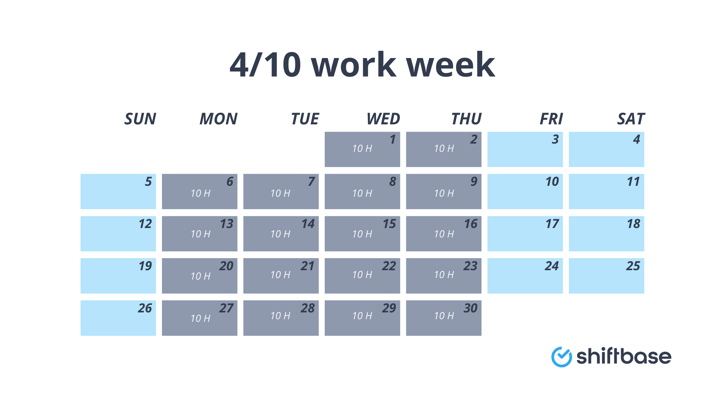What is a 4/10 work schedule?
The 4/10 work schedule means employees work four days a week, putting in 10 hours per day, and then enjoy a three-day weekend. This work schedule is also know as as the 4 on 3 off shift pattern schedule.
This compressed schedule stands in contrast to the more familiar five days per week, eight-hour days model we often see in workplaces.
Is the 4/10 work schedule the same as a 4-day work week?
A 4/10 work schedule and a four-day workweek both involve employees working four days per week, but they differ in total weekly hours and daily work duration.
Here's a comparative table highlighting the key differences between a 4/10 work schedule and a four-day workweek:
| Aspect |
4/10 Work Schedule |
Four-Day Workweek |
| Definition |
Employees work four days a week, each consisting of 10-hour shifts, totaling 40 hours per week. |
Employees work four days a week, with daily hours varying based on the organization's policies, often resulting in fewer than 40 total hours per week. |
| Total Weekly Hours |
40 hours |
Typically less than 40 hours |
| Daily Work Hours |
10 hours |
Varies; often standard 8-hour days or less |
| Objective |
To maintain a standard 40-hour workweek by compressing hours into fewer days, providing an extra day off. |
To reduce overall working hours to enhance work-life balance and potentially improve productivity. |
| Example Schedule |
Monday to Thursday: 8:00 AM – 6:00 PM; Friday to Sunday: Off |
Monday to Thursday: 9:00 AM – 5:00 PM; Friday to Sunday: Off |
| Overtime Implications |
May require overtime pay for hours exceeding daily limits, depending on jurisdiction. |
Generally not applicable, as daily hours usually remain within standard limits. |
| Employee Well-being |
Offers longer weekends but may lead to daily fatigue due to extended hours. |
Provides additional days off, potentially reducing burnout and improving overall well-being. |
Benefits of the 4/10 work schedule
For many businesses and their employees, this alternative work schedule has become a game changer. Here's why:
1. Employee well-being and work-life balance
With the 4/10 schedule, employees get to relish an extra day off. This not only means more relaxation and personal time but also contributes to a better work-life balance. Employees benefit from an additional day off each week, providing more time for personal activities, rest, and family commitments.
2. Reduced Commuting
With one less day of commuting, employees save time and transportation costs, potentially reducing stress and contributing to environmental benefits.
3. Enhanced Productivity
Longer workdays can lead to periods of increased focus and productivity, as employees have extended time to complete tasks without daily interruptions.
4. Improved Employee Satisfaction
Offering a compressed workweek can make a company more attractive to top talent, aiding in recruitment and retention efforts.
Disadvantages of 4/10 schedule
Like all work schedules, the 4/10 has its share of challenges. While the allure of a four-day workweek is tempting, employers and HR professionals should be aware of some concerns:
1. Employee Fatigue
Extending the workday to 10 hours can lead to increased fatigue, potentially decreasing productivity and increasing the likelihood of errors or accidents.
2. Work Schedule Incompatibility
Longer workdays may conflict with employees' personal responsibilities, such as childcare or evening commitments, making it challenging for some to adapt to the new schedule.
3. Reduced Staff Coverage
With fewer days in the office, there may be challenges in maintaining adequate coverage for customer service or collaboration, potentially impacting business operations.
4. Overtime Regulations
In certain jurisdictions, working more than eight hours a day may require overtime compensation, leading to increased labor costs for employers.
When considering a 4/10 work schedule, it's essential to weigh these factors carefully to determine if this arrangement aligns with your organization's operational needs and employee well-being.

Statistics on 4/10 work schedules
Recent studies have examined the implications of implementing a 4/10 work schedule, where employees work four 10-hour days each week. Notable findings include:
-
Employee Preferences: A survey revealed that 56% of employees favor a 40-hour workweek condensed into four days over the traditional five-day schedule.
-
Productivity Insights: Research indicates that 77% of workers report heightened productivity when adhering to a four-day workweek.
-
Employee Well-being: Studies have found that 78% of employees experience increased happiness and reduced stress after transitioning to a four-day workweek.
-
Employer Adoption: Approximately 33% of organizations now offer compressed workweeks, allowing employees to work 40 hours over four days.
These findings suggest that a 4/10 work schedule can enhance employee satisfaction and productivity. However, it's essential to consider potential challenges, such as increased daily fatigue and the need for effective time management, to ensure successful implementation.
Implementing the 4/10 work schedule
Implementing a 4/10 work schedule, where employees work four 10-hour days each week, requires a structured approach to ensure a smooth transition and maintain operational efficiency. The following steps can guide you through this process:
1. Assessment of Feasibility
-
Operational Analysis: Evaluate whether a 4/10 schedule aligns with your business operations. Consider factors such as customer service hours, project deadlines, and the need for continuous coverage. For instance, businesses requiring consistent customer-facing operations might need to adjust staffing to ensure coverage throughout the week.
-
Legal Compliance: Review labor laws and regulations in your jurisdiction to ensure compliance with overtime rules, break requirements, and other legal considerations. In some regions, working more than eight hours a day may necessitate overtime pay, even under a compressed schedule.
-
Resource Evaluation: Assess whether your current resources, including staffing levels and infrastructure, can support extended daily operations. This includes evaluating the impact on utilities, maintenance, and other operational costs.
2. Employee Consultation
-
Surveys and Feedback: Engage with employees to gauge their interest and gather input on the proposed schedule change. Understanding their preferences and concerns is crucial for a successful transition.
-
Addressing Concerns: Identify potential challenges employees may face, such as childcare arrangements or transportation issues, and work collaboratively to find solutions. Open communication can help mitigate resistance and foster acceptance.
3. Pilot Testing
-
Trial Period: Implement the 4/10 schedule on a trial basis to evaluate its impact on productivity, employee satisfaction, and overall operations. A pilot program allows for adjustments before full-scale implementation.
-
Monitoring and Evaluation: During the pilot, closely monitor key performance indicators and gather feedback to assess the schedule's effectiveness. This data-driven approach facilitates informed decision-making.
4. Full Implementation
-
Policy Development: Based on insights from the pilot, establish formal policies outlining the 4/10 schedule, including work hours, expectations, and procedures for requesting schedule changes. Clear guidelines ensure consistency and transparency.
-
Ongoing Support: Provide resources and support to help employees adapt to the new schedule. This may include offering flexible start and end times to accommodate individual needs.
By following these steps, organizations can effectively transition to a 4/10 work schedule, balancing operational requirements with employee well-being.

Legal and HR implications
Implementing a 4/10 work schedule, where employees work four 10-hour days each week, necessitates careful consideration of various legal aspects to ensure compliance and maintain employee well-being. Key considerations include:
Overtime considerations
- United States: Under the Fair Labor Standards Act (FLSA), overtime is typically calculated on a weekly basis, requiring employers to pay time and a half for hours worked beyond 40 in a workweek. However, certain states, such as California, have daily overtime requirements. In California, employees must receive overtime pay for hours worked beyond 8 in a day, even if they do not exceed 40 hours in a week. Implementing a 4/10 schedule in such states may require an Alternative Workweek Schedule (AWS) agreement to comply with state labor laws.
- United Kingdom: In the UK, there is no statutory requirement to pay higher rates for overtime unless stipulated in the employment contract. However, average pay must not fall below the National Minimum Wage, and total working hours must comply with the Working Time Regulations, which generally limit weekly working hours to 48 unless the employee has opted out.
Employment Contracts
- Contractual Obligations: Transitioning to a 4/10 schedule may require amendments to existing employment contracts, particularly concerning working hours, overtime provisions, and break entitlements. Employers should consult with employees and obtain their agreement to any contractual changes, ensuring that all modifications are documented in writing.
- Policy Updates: Employers should update company policies and employee handbooks to reflect the new work schedule, including details on overtime calculations, break periods, and procedures for addressing any scheduling conflicts.
Break Requirements
- United States: Federal law does not mandate meal or rest breaks, but many states have their own requirements. For example, California requires a 30-minute unpaid meal break for every 5 hours worked and a paid 10-minute rest break for every 4 hours worked. Employers must ensure that extended workdays under a 4/10 schedule comply with state-specific break laws to prevent violations.
- United Kingdom: The Working Time Regulations entitle workers to a 20-minute uninterrupted rest break if the working day exceeds 6 hours. Additionally, workers are entitled to 11 consecutive hours of rest between working days and either an uninterrupted 24 hours without work each week or 48 hours each fortnight. Employers should assess whether longer working days necessitate additional breaks to maintain health and safety.
Other considerations:
-
Health and Safety: Longer workdays can lead to increased fatigue, potentially impacting employee health and safety. Employers have a duty of care to monitor workloads and ensure that the 4/10 schedule does not adversely affect employee well-being.
-
Right to Disconnect: In some jurisdictions, there is a growing emphasis on employees' rights to disconnect from work outside of scheduled hours. Employers should establish clear boundaries to respect employees' personal time, especially with extended daily hours.
-
Jurisdictional Variations: Labor laws vary significantly between jurisdictions. Employers operating in multiple locations must ensure that the 4/10 schedule complies with all relevant local, state, and national regulations.
Employers should conduct a thorough legal review and consult with legal professionals to navigate the complexities associated with implementing a 4/10 work schedule, ensuring full compliance with all applicable laws and regulations.
Comparison with other alternative work schedules
The evolving dynamics of the modern workplace have given rise to several alternative work schedules. While the 4/10 work schedule has its unique advantages, it's beneficial to compare it with other popular models to provide a clearer picture of its position in the landscape.
1. The 9/80 work schedule
The 9/80 work schedule splits two work weeks into a nine-day cycle. Employees work nine 9-hour days over these two weeks and get every other Friday off, effectively providing a long weekend every other week.
Comparison with 4/10: Both the 9/80 and the 4/10 offer employees an extended weekend, but the distribution of hours is different. While the 4/10 can be more intense with 10-hour days, the 9/80 offers a more spread-out approach, which some might find easier to manage. Additionally, with the 9/80, businesses remain open five days a week, reducing concerns about customer or client service gaps.
Useful Read: What Does an 80 Hour Work Week Look Like? A Guide
2. Flextime
Flextime provides employees the flexibility to choose their starting and ending times within certain limits set by employers. This arrangement gives workers a sense of autonomy and can aid in balancing personal and professional commitments.
Comparison with 4/10: While the 4/10 offers a fixed yet compressed schedule, flextime offers variability. An employee on flextime might opt for longer hours on some days and shorter on others, but without the commitment of consistent 10-hour days. Flextime might be more suitable for businesses and employees looking for daily flexibility rather than a fixed, longer weekend.
3. Remote work and hybrid models
Remote work allows employees to work from locations other than the office, usually from home. A hybrid model combines remote work with in-office days, allowing for a balance of both.
Comparison with 4/10: The 4/10 schedule focuses on the distribution of hours within a week, while remote and hybrid models address the location and sometimes the distribution of work. Combining the 4/10 with remote work could offer employees significant flexibility, reducing commute times and potentially making 10-hour days more manageable.
Hybrid models with a 4/10 structure could be the best of both worlds, giving employees the benefits of both face-to-face interactions and the autonomy of remote work, coupled with longer weekends.
Useful Read: How to engage remote employees: Tips and Strategies
Tools and software for managing a 4/10 work schedule

Adopting a 4/10 work schedule brings its own set of unique challenges. But in today's tech-savvy world, there's a software solution for almost every hurdle. Here are essential tools that can aid in managing a compressed work week seamlessly:
Time-tracking software
For both employers and employees, tracking the 10-hour workday is vital. Time-tracking software ensures that every minute is accounted for, helping in keeping an accurate record of hours worked.
Tools like Shiftbase are user-friendly options that not only log hours but also offer insights into productivity and breaks. This assists in ensuring that despite the longer day, employees are taking necessary pauses and not overextending themselves.
Communication tools
When working on a compressed schedule, clear and efficient communication becomes even more essential. Platforms like Slack or Microsoft Teams offer instant messaging, video calls, and file-sharing, making it easier to address potential scheduling conflicts and maintain team cohesion.
They also allow for the creation of dedicated channels or groups, ensuring that everyone is updated and on the same page, even if they aren't working on the same day.
Useful Read: 12 best ways to handle scheduling conflicts: A Guide for HR Managers
Task management platforms
In a 4/10 work schedule, it's crucial that no task is overlooked. Task management platforms such as Trello, Asana, or Monday.com can be particularly beneficial. They allow teams to visualize workloads, assign tasks, and set deadlines.
With features like calendar views, integrations with other tools, and notifications, they ensure that despite the unique work schedule, projects remain on track and no essential tasks fall through the cracks.
Conclusion
While the 4/10 work schedule offers numerous benefits, ranging from enhanced work-life balance to reduced commuting burdens, its success is contingent on its alignment with individual and organizational needs.
Ultimately, the ability of a company to harness its advantages while navigating potential challenges underscores the importance of understanding, flexibility, and adaptability in the evolving landscape of employment.
Optimize your 4/10 work schedule with Shiftbase
Adopting a 4/10 work schedule can be straightforward with the right tools. Shiftbase allows you to easily set up and manage such schedules, aligning them with your business needs and employee shift preferences. Our features, including employee scheduling and time tracking, ensure that the transition is seamless and the implementation effective.
Ready to explore the benefits of a 4/10 work schedule? Start a free 14-day trial with Shiftbase and optimize your approach to work-life balance.

Your work schedule in one central place!





